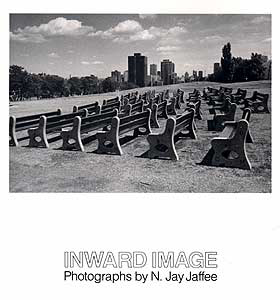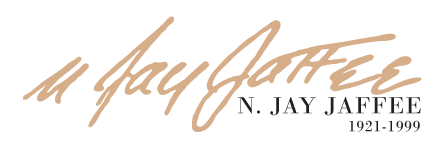 Foreword by Michael Botwinick, Director
Foreword by Michael Botwinick, Director
As objects, photographs are the most accessible of all. We often relate them to the snapshots with which we fill our family album. The work of N. Jay Jaffee demonstrates how wrong such an oversimplification can be. His apparently straightforward photographs occupy another level. He displays a razor sharp eye, building with composition and tone to capture and freeze a tissue-paper thin slice of reality. This exhibition…is a reminder of photography’s potential in the hands of a gifted artist.
Introduction by Gene Baro, Curator
Many photographs of established reputation have used the camera to brilliant effect as a recording device. They have seized the moment, replying upon a selection and editorial eye, or else, by the same means, have imparted an aura of their personality to things, places, and people seen deliberately. The authority of a Cartier-Bresson, a Bernice Abbott, and Edward Weston, an André Kertesz is as much in the social values they give to the life before their lenses as to the subject stripped of the photographer’s fateful intervention, perhaps more. In the best sense, these photographers record mornings, communication meanings embodied in images whose equivalents may be been seen by many others and gone unrecognized.
With N. Jay Jaffee, the quest for meaning—for the communicable truth before his lens—has been part of a search for self-identity. He is an autobiographical photographer, recording images of his ambient city and beyond, probing what has moved him. Possibly in consequence, his photographs are free and unmannered, unconstrained by program or attitude. They suggest a reaching out, and they invite us likewise to see and to question with an innocent eye.
Jaffee’s images involved us in reflection and in memory. Even at their most realistic and concrete they hint at the fugitive. We know that the streetcorner conversation will break up and the participants reenter their separate mysterious lives. We know that the sun will pass from the upturned faces of the sunworshipers. And the shop so artfully and amusingly hung with signs and tires will be gone in a moment, giving way for something else, is perhaps gone already.
Jaffee’s sensibility is introspective and meditative without being nostalgic or sentimental. The fleeting world reflects the changing self, and often Jaffee succeeds in holding both in his lens. A reaching out and a letting go—this ambiguity is in the best of Jaffee’s work.
The work is characterized, too, by Jaffee’s uncommon gift as an artist in black and white. He seems to have a virtually unerring sense of tonal structure. He sees in subtle and sparkling gradations and pattern of tone. This is a strength that has to do with the formal organization of a photograph, whatever its ostensible subject. It gives the abstract visual interest intrinsic to photographic art.
Beyond this there is the variety of Jaffee’s images to consider. He has taken New York for his own, but not in any journalistic or expository way. The record is a record of feelings. It extends equally to the countryside and to Paris. More important is that Jaffee manages with apparent ease man and landscape, architecture and seascape, the intimate and the abstract, the momentary and the timeless.
